
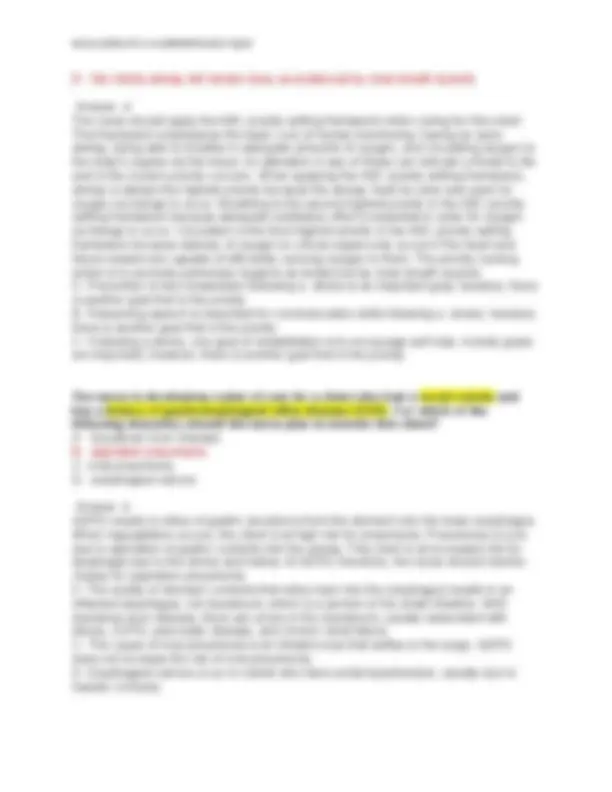
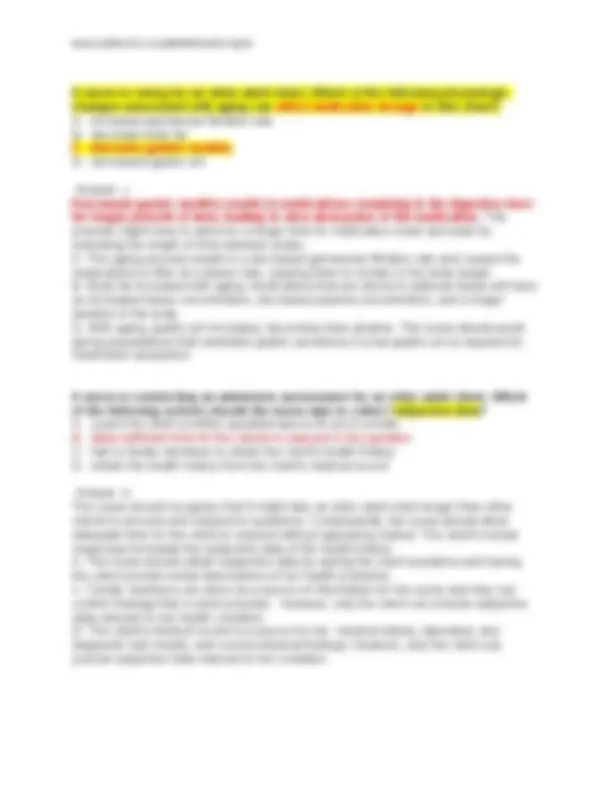
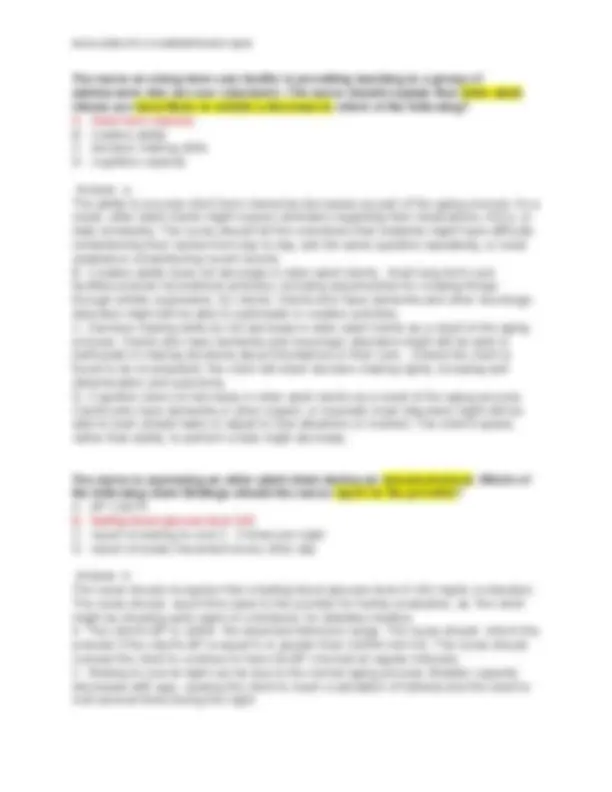
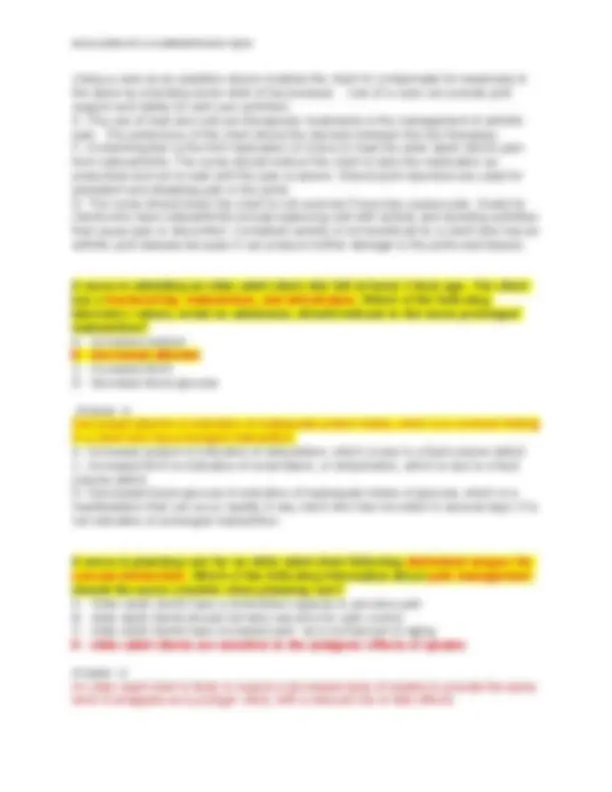
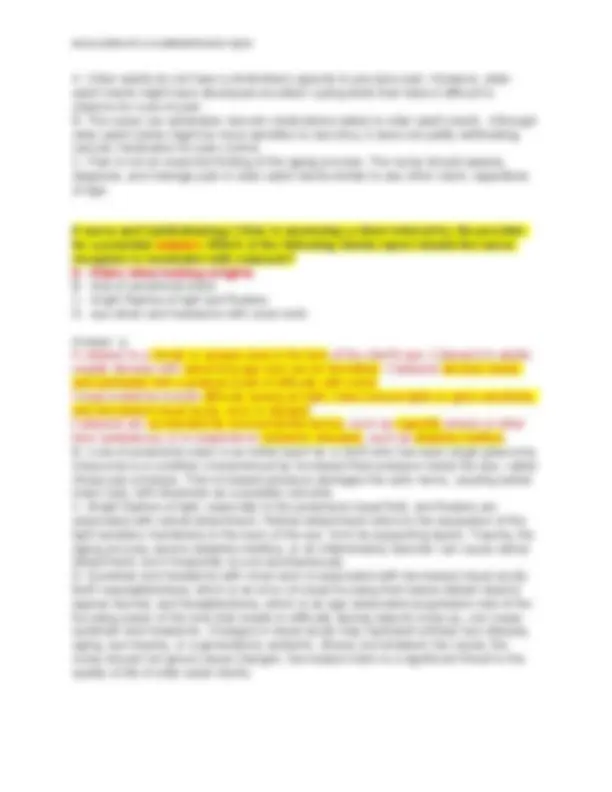
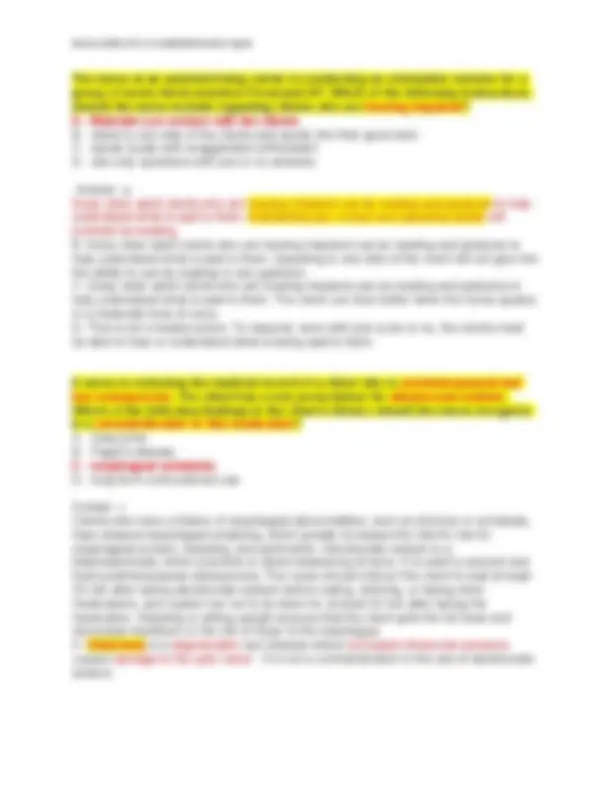
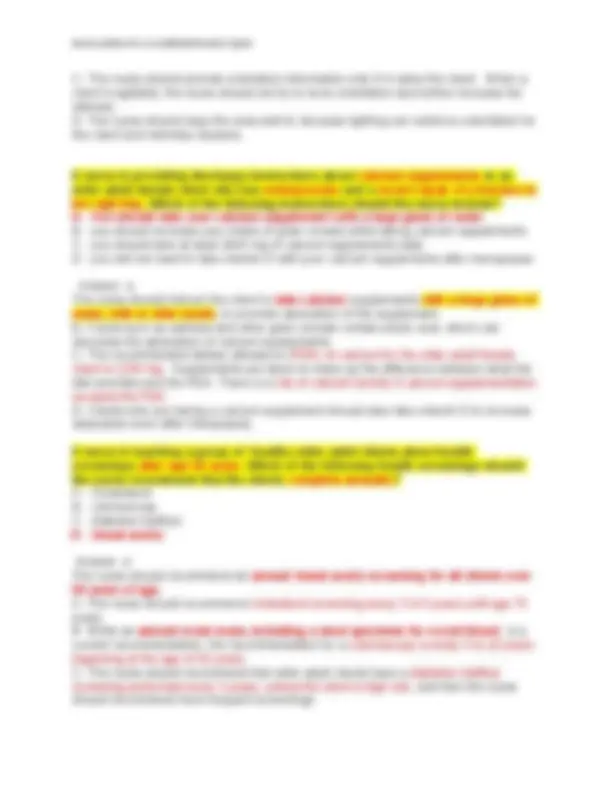
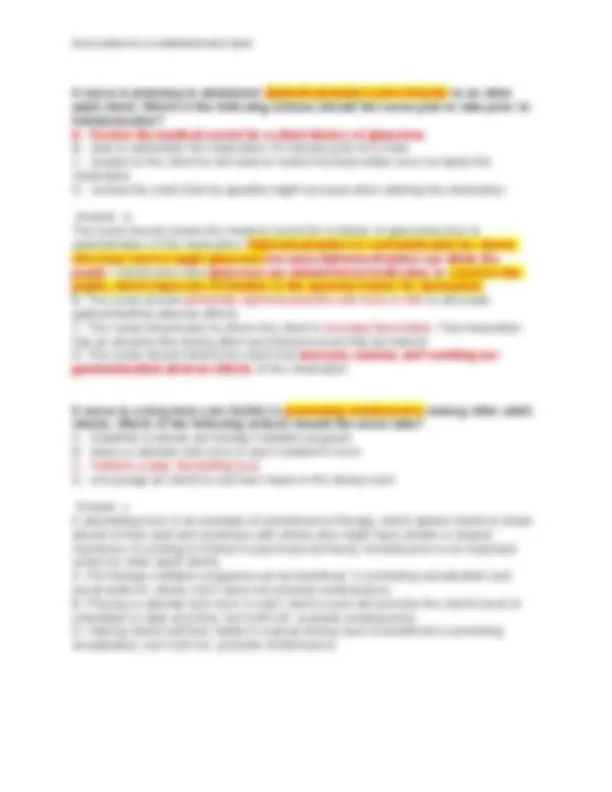
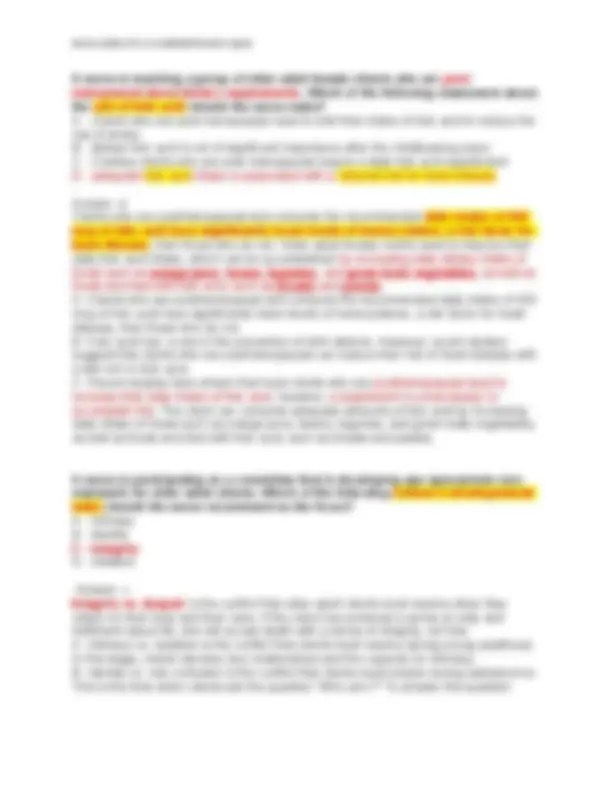
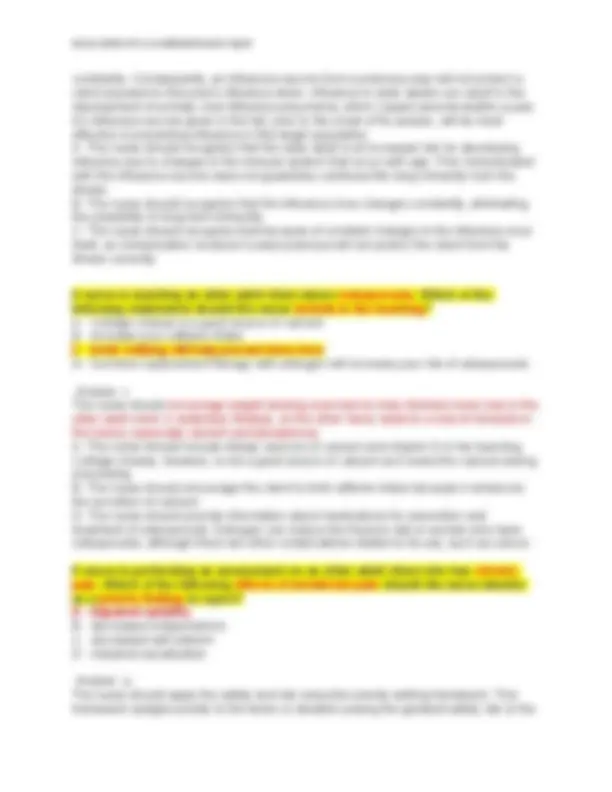
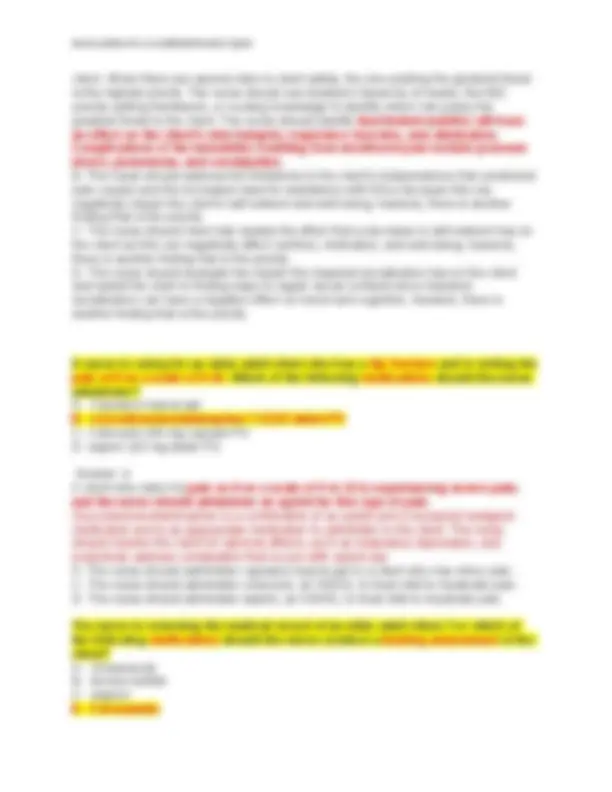
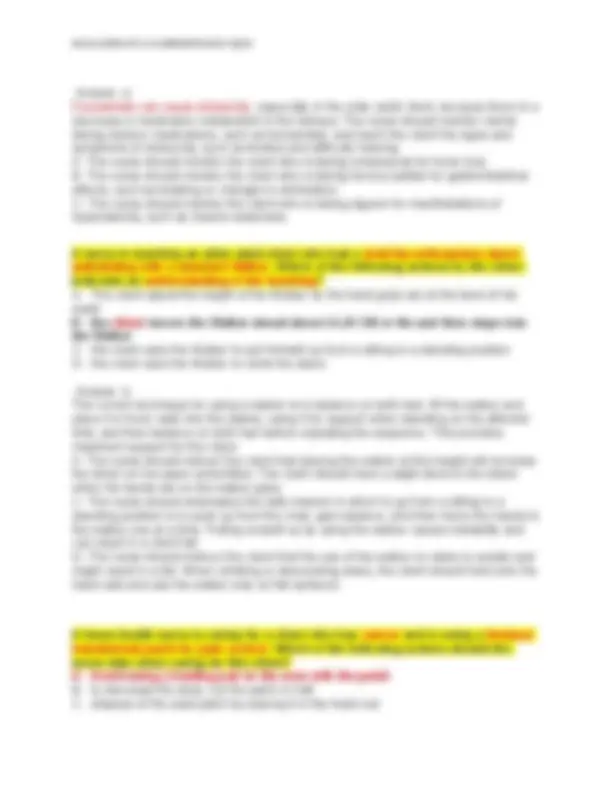
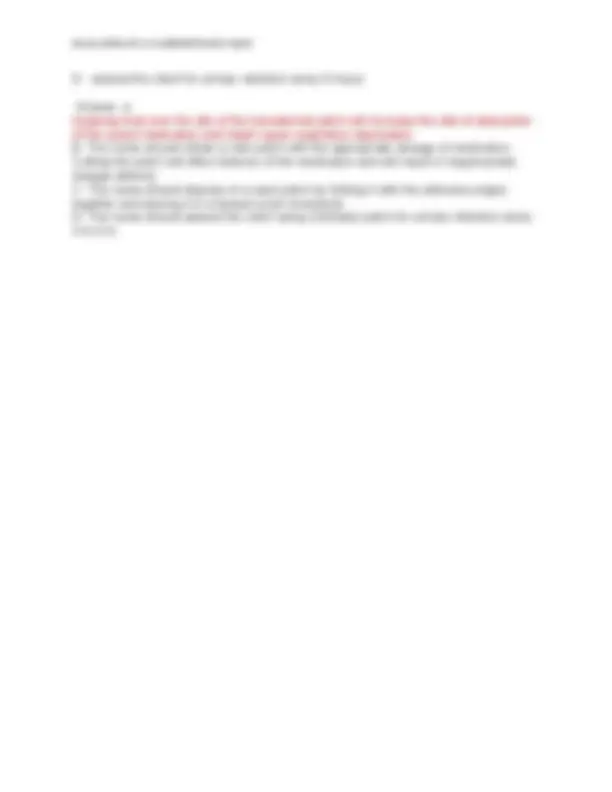


Study with the several resources on Docsity

Earn points by helping other students or get them with a premium plan


Prepare for your exams
Study with the several resources on Docsity

Earn points to download
Earn points by helping other students or get them with a premium plan
Community
Ask the community for help and clear up your study doubts
Discover the best universities in your country according to Docsity users
Free resources
Download our free guides on studying techniques, anxiety management strategies, and thesis advice from Docsity tutors
N212 GERO ATI 2.0 GERONTOLOGY QUIZ (Gerontology, Folic acid, postmenopausal osteoporosis)
Typology: Exams
1 / 21

This page cannot be seen from the preview
Don't miss anything!














The nurse is teaching an older adult client who is on bed rest following development of deep vein thrombosis DVT about methods to increase peristalsis. Which of the following high-fiber food choices should the nurse recommend? A- Navy bean soup B- canned fruit juice C- white rice pudding D- soy milk Answer- A An older adult client who is on bedrest has an increased risk for constipation due to the decreased peristalsis associated with the aging process. Increasing dietary fiber by adding foods like legumes to the diet, as well as ensuring adequate fluid intake, will promote bowel regularity. B- The nurse should recommend canned fruit and fruit juices without pulp as a low-fiber choice, which can help decrease peristalsis. C- The nurse should recommend white rice pudding as a low-fiber choice, which can help decrease peristalsis. D- The nurse should recommend soy milk as a low-fiber choice, which can help decrease peristalsis. A home health nurse is visiting an older adult client who has anemia. Which of the following foods should the nurse recommend to increase the clients iron intake? A- Greek yogurt B- bran muffin C- peanut butter sandwich D- dried fruit Answer- d The nurse should recommend the client eat more dried fruit to increase iron in the diet. A- The nurse should recommend greek yogurt to increase the client’s intake of zinc and calcium. B- The nurse should recommend bran muffins to increase the client’s intake of fiber. C- The nurse should recommend a peanut butter sandwich to increase the client's intake of a complementary protein, which is when two incomplete proteins are together, making the sandwich a complete protein. The nurse is caring for an older adult client who has a new onset of type 2 diabetes mellitus. Which of the following psychological changes can contribute to the development of type 2 diabetes? A- Increased production of insulin by the pancreas B- decrease sensitivity to be circulating insulin C- increase rate of glucose metabolism D- decreased release of glycogen by the liver
Answer- b The pancreas in older adult clients demonstrates reduced tissue sensitivity to circulating insulin, leading to an increased risk of developing type 2 diabetes mellitus. A- There is an insufficient release of insulin by the beta cells within the pancreas with type 2 diabetes mellitus. C- There is a decrease in the rate of glucose metabolism in older adult clients. This is especially true if there is a sudden, high concentration of glucose consumed. D- Glucose is stored in the liver as glycogen. A decrease in the amount of glycogen converted to glucose and released to the body results in a decrease in blood glucose, rather than an elevation. The nurse is teaching a newly hired assistive Personnel about her role in helping older adult clients with activities of daily living ADLs. the nurse should explain that which of the following is the most common factor for the FX a client's performance of adl's? A- social withdrawal B- chronic physical disability C- emotional impairment D- cognitive dysfunction Answer- b Physical disability is the most common reason older adult clients have difficulty performing ADLs. Self-care deficit, the nursing diagnosis that describes the inability of the client to perform self-care activities necessary for optimum health and function, is associated with several physical etiologic factors: activity intolerance, pain, neuromuscular impairment, sensory-perceptual impairment, musculoskeletal impairment, and cognitive impairment. A- Although some older adult clients might become socially withdrawn due to depression, physical debilitation, or lack of transportation, it should not affect their ability to perform ADLs. C- Emotional stability does not decrease in older adult clients as a consequence of the aging process. While depression is common in older adult clients, it is often associated with a serious or disabling medical diagnosis, physical impairment, or as a side effect of medications. Clients who are depressed might, as a result of their mood disorder, be reluctant to perform their ADLs and need assistance or encouragement. D- Cognition does not decrease in older adults as a consequence of the aging process. Even clients who have dementia and other neurologic disorders might still be able to learn and perform tasks, such as ADLs, or adjust to new situations or routines. The nurse is planning care for a client who had a stroke. Which of the following goals should the nurse identify as the priority for this client? A- The clients skip will remain intact during hospitalization B- the client will verbalize one new word each week C- the client will begin to help turn himself in bed, indicating improve Mobility
A nurse is caring for an older adult client. Which of the following physiologic changes associated with aging can affect medication dosage in this client? A- Increased glomerular filtration rate B- decrease body fat C- decrease gastric motility D- decreased gastric pH Answer- c Decreased gastric motility results in medications remaining in the digestive tract for longer periods of time, leading to slow absorption of the medication. The provider might have to allow for a longer time for medication onset and peak by extending the length of time between doses. A- The aging process results in a decreased glomerular filtration rate and causes the medications to filter at a slower rate, causing them to remain in the body longer. B- Body fat increases with aging. Medications that are stored in adipose tissue will have an increased tissue concentration, decreased plasma concentration, and a longer duration in the body. D- With aging, gastric pH increases, becoming more alkaline. The nurse should avoid giving preparations that neutralize gastric secretions if a low gastric pH is required for medication absorption. A nurse is conducting an admission assessment for an older adult client. Which of the following actions should the nurse take to collect subjective data? A- Leave the client a written questionnaire to fill out in private B- allow sufficient time for the clients to respond to the question C- talk to family members to obtain the client's health history D- obtain the health history from the client's medical record Answer- b The nurse should recognize that it might take an older adult client longer than other clients to process and respond to questions. Consequently, the nurse should allow adequate time for the client to respond without appearing rushed. The client’s verbal responses formulate the subjective data of the health history. A- The nurse should obtain subjective data by asking the client questions and having the client provide verbal descriptions of her health problems. C- Family members can serve as a source of information for the nurse and they can confirm findings that a client provides. However, only the client can provide subjective data relevant to her health condition. D- The client's medical record is a source for her medical history, laboratory and diagnostic test results, and current physical findings. However, only the client can provide subjective data relevant to her condition.
The nurse at a long-term care facility is providing teaching to a group of adolescents who are new volunteers. The nurse should explain that older adult clients are most likely to exhibit a decrease in which of the following? A- Short-term memory B- creative ability C- decision making skills D- cognitive capacity Answer- a The ability to process short-term memories decreases as part of the aging process. As a result, older adult clients might require reminders regarding their medications, ADLs, or daily schedules. The nurse should tell the volunteers that residents might have difficulty remembering their names from day to day, ask the same question repeatedly, or need assistance remembering recent events. B- Creative ability does not decrease in older adult clients. Most long-term care facilities provide recreational activities, including opportunities for creating things through artistic expression, for clients. Clients who have dementia and other neurologic disorders might still be able to participate in creative activities. C- Decision-making skills do not decrease in older adult clients as a result of the aging process. Clients who have dementia and neurologic disorders might still be able to participate in making decisions about themselves or their care. Unless the client is found to be incompetent, the client will retain decision-making rights, including self- determination and autonomy. D- Cognition does not decrease in older adult clients as a result of the aging process. Clients who have dementia or other organic or traumatic brain disorders might still be able to learn simple tasks or adjust to new situations or routines. The client's speed, rather than ability, to perform a task might decrease. The nurse is assessing an older adult client during an annual physical. Which of the following client findings should the nurse report to the provider? A- BP 118/ B- fasting blood glucose level 160 C- report of waking to void 2 - 3 times per night D- report of bowel movement every other day Answer- b The nurse should recognize that a fasting blood glucose level of 160 mg/dL is elevated. The nurse should report this value to the provider for further evaluation, as the client might be showing early signs of a tendency for diabetes mellitus. A- The client's BP is within the expected reference range. The nurse should inform the provider if the client’s BP is equal to or greater than 140/90 mm HG. The nurse should counsel the client to continue to have his BP checked at regular intervals. C- Waking to void at night can be due to the normal aging process. Bladder capacity decreases with age, causing the client to reach a sensation of fullness and the need to void several times during the night.
B- A physiologic change associated with aging is a decreased diameter of the small airways. However, the diameter of the large airways does increase with age, and these two factors combined can lead to an increase in dead space, gas trapping, and ventilation-perfusion imbalance. D- A physiologic change associated with aging is an increase in the size of the alveolar ducts and respiratory bronchioles, leading to a decrease in the alveolar surface area. Consequently, there is less surface area for gas exchange to occur, putting the client at an increased risk for hypoxemia. The nurse in the clinic is assessing an older adult client for the second time in a week. The client reports a decrease in energy levels, insomnia, and anorexia. The client's diagnostic tests are within the expected reference ranges. For which of the following conditions should the nurse screen the client? A- Sarcopenia B- dementia C- depression D- diabetes Answer- c Depression, an altered mood state characterized by decreased energy levels, insomnia, anorexia, and sadness, is a common condition among older adult clients. Depression can be a response to an acute or chronic illness. Depression in older adult clients can also be the result of medications such as analgesics, antihypertensives, steroids, and cardiovascular agents. A- Sarcopenia is an impairment of muscle tone. The loss of muscle tone is caused by physical inactivity, a change in the central and peripheral nervous systems, and reduced skeletal protein synthesis. B- Dementia refers to a group of symptoms involving progressive impairment of all aspects of brain function. Most of the disorders associated with dementia are irreversible, degenerative conditions. D- The presenting manifestations of diabetes mellitus, a condition caused by the inability of the pancreas to secrete enough insulin for carbohydrate metabolism, include polydipsia, polyuria, and polyphagia. Polyuria is also a manifestation of diabetes insipidus, which is a condition caused by the inability of the kidneys to conserve water. A nurse is providing teaching to an older adult client who has osteoarthritis of the right hip and lower lumbar vertebrae. Which of the following statements by the client indicates an understanding of the teaching? A- I should avoid the use of a heating pad on my back B- to relieve the pressure on my hip, I can use a cane while ambulating C- I will have steroid injections to my joint has the first medication of choice to treat my pain D- I will exercise even when it causes pain Answer- b
Using a cane as an assistive device enables the client to compensate for weakness in the spine by providing some relief of hip pressure. Use of a cane can provide joint support and safety for self-care activities. A- The use of heat and cold are therapeutic treatments in the management of arthritic pain. The preference of the client drives the decision between the two therapies. C- Acetaminophen is the first medication of choice to treat the older adult client’s pain from osteoarthritis. The nurse should instruct the client to take the medication as prescribed and not to wait until the pain is severe. Steroid joint injections are used for persistent and disabling pain in the joints. D- The nurse should teach the client to not exercise if exercise causes pain. Goals for clients who have osteoarthritis include balancing rest with activity and avoiding activities that cause pain or discomfort. Consistent activity is not beneficial for a client who has an arthritic joint disease because it can produce further damage to the joints and tissues. A nurse is admitting an older adult client who fell at home 3 days ago. The client has a fractured hip, malnutrition, and dehydration. Which of the following laboratory values, noted on admission, should indicate to the nurse prolonged malnutrition? A- Increased sodium B- decreased albumin C- increased BUN D- decrease blood glucose Answer- b Decreased albumin is indicative of inadequate protein intake, which is a common finding in a client who has prolonged malnutrition. A- Increased sodium is indicative of dehydration, which is due to a fluid volume deficit. C- Increased BUN is indicative of renal failure, or dehydration, which is due to a fluid volume deficit. D- Decreased blood glucose is indicative of inadequate intake of glucose, which is a manifestation that can occur rapidly in any client who has not eaten in several days. It is not indicative of prolonged malnutrition. A nurse is planning care for an older adult client following abdominal surgery for a bowel obstruction. Which of the following information about pain management should the nurse consider when planning care? A- Older adult clients have a diminished capacity to perceive pain B- older adult clients should not take narcotics for pain control C- older adult clients have increased pain as a normal part of aging D- older adult clients are sensitive to the analgesic effects of opiates Answer- d An older adult client is likely to require a decreased dose of opiates to provide the same level of analgesia as a younger client, with a reduced risk of side effects.
The nurse at an assisted living center is conducting an orientation session for a group of newly hired assistive Personnel AP. Which of the following instructions should the nurse include regarding clients who are hearing impaired? A- Maintain eye contact with the clients B- stand to one side of the clients and speak into their good ears C- speak loudly with exaggerated enthusiasm D- ask only questions with yes or no answers Answer- a Many older adult clients who are hearing impaired use lip-reading and gestures to help understand what is said to them. Maintaining eye contact and speaking slowly will promote lip-reading. B- Many older adult clients who are hearing impaired use lip-reading and gestures to help understand what is said to them. Speaking to one side of the client will not give him the ability to use lip-reading or see gestures. C- Many older adult clients who are hearing impaired use lip-reading and gestures to help understand what is said to them. The client can hear better when the nurse speaks in a moderate tone of voice. D- This is not a helpful action. To respond, even with just a yes or no, the clients must be able to hear or understand what is being said to them. A nurse is reviewing the medical record of a client who is postmenopausal and has osteoporosis. The client has a new prescription for alendronate sodium. Which of the following findings in the client's history should the nurse recognize is a contraindication to this medication? A- Glaucoma B- Paget’s disease C- esophageal achalasia D- long-term corticosteroid use Answer- c Clients who have a history of esophageal abnormalities, such as stricture or achalasia, have delayed esophageal emptying, which greatly increases the client’s risk for esophageal erosion, bleeding, and perforation. Alendronate sodium is a bisphosphonate, which prevents or slows weakening of bone. It is used to prevent and treat postmenopausal osteoporosis. The nurse should instruct the client to wait at least 30 min after taking alendronate sodium before eating, drinking, or taking other medications, and caution her not to lie down for at least 30 min after taking the medication. Standing or sitting upright ensures that the client gets the full dose and decreases heartburn or the risk of injury to the esophagus. A- Glaucoma is a degenerative eye disease where increased intraocular pressure causes damage to the optic nerve. It is not a contraindication to the use of alendronate sodium.
B- Paget’s disease is a metabolic bone disease that involves bone destruction and regrowth that results in deformity. Medical treatment with a bisphosphonate, such as alendronate sodium, is considered first-line therapy. D- Long-term steroid use is frequently associated with the development of osteoporosis, and treatment with a bisphosphonate is considered first-line therapy. Alendronate sodium is a bisphosphonate, which prevents or slows weakening of bone. It is used to prevent and treat postmenopausal osteoporosis and Paget’s disease. A nurse is caring for a client who has Alzheimer's disease and refuses to take her morning antihypertensive medication. The client is oriented to name and place and is able to perform adl's with minimal supervision. Which of the following actions should the nurse take? A- Crush the pill and feed them to the client in applesauce B- insist the client can fly by informing her of the possible implications of missing a dose C- notify the provider of the need for further evaluation of the clients level of competence D- ask the client to express her reasons for refusing the medication and document the event Answer- d Before intervening or making a judgment about the client’s competence, the nurse should evaluate the client. The nurse should then determine if the client's reason for refusal can be addressed. A- Forcing or tricking a client into taking medication or receiving treatment is unethical and can constitute battery. B- Being confrontational can cause the client to become argumentative and distrustful. The nurse should not insist the client take her medications. C- A single incident of refusing medication is unlikely to place the client’s competence in question. A nurse is assessing an older adult client who states he is homeless. Which of the following findings should the nurse document as comorbidities for this client? A- An adequate shelter and clothing for the weather B- malnutrition and poverty C- dementia and tuberculosis D- lack of preventive health care and immunizations Answer- c The term comorbidity refers to medical conditions known to co-exist in a client. The number of comorbid conditions present in a client is used to provide an indication of his health status and risk of death. Dementia and tuberculosis occurring in an individual client is an example of comorbidity and increases the client’s risk.
C- The nurse should provide orientation information only if it calms the client. When a client is agitated, the nurse should not try to force orientation and further increase his distress. D- The nurse should keep the area well lit, because lighting can reinforce orientation for the client and minimize illusions. A nurse is providing discharge instructions about calcium supplements to an older adult female client who has osteoporosis and a recent repair of a fracture in her right hip. Which of the following instructions should the nurse include? A- You should take your calcium supplement with a large glass of water B- you should increase your intake of grain cereals while taking calcium supplements C- you should take at least 2600 mg of calcium supplements daily D- you will not need to take vitamin D with your calcium supplements after menopause Answer- a The nurse should instruct the client to take calcium supplements with a large glass of water, with or after meals , to promote absorption of the supplement. B- Foods such as oatmeal and other grain cereals contain phytic acid, which can decrease the absorption of calcium supplements. C- The recommended dietary allowance (RDA) of calcium for the older adult female client is 1200 mg. Supplements are taken to make up the difference between what the diet provides and the RDA. There is a risk of calcium toxicity if calcium supplementation exceeds the RDA. D- Clients who are taking a calcium supplement should also take vitamin D to increase absorption even after menopause. A nurse is teaching a group of healthy older adult clients about health screenings after age 50 years. Which of the following Health screenings should the nurse recommend that the clients complete annually? A- Cholesterol B- colonoscopy C- diabetes mellitus D- visual acuity Answer- d The nurse should recommend an annual visual acuity screening for all clients over 50 years of age. A- The nurse should recommend cholesterol screening every 3 to 5 years until age 75 years. B- While an annual rectal exam, including a stool specimen for occult blood , is a current recommendation, the recommendation for a colonoscopy is every 5 to 10 years beginning at the age of 50 years. C- The nurse should recommend that older adult clients have a diabetes mellitus screening performed every 3 years, unless the client is high risk, and then the nurse should recommend more frequent screenings.
A nurse is planning to administer diphenhydramine hydrochloride to an older adult client. Which of the following actions should the nurse plan to take prior to Administration? A- Review the medical record for a client history of glaucoma B- plan to administer the medication 30 minutes prior to a male C- explain to the client he will need to restrict his fluid intake once he takes the medication D- remind the client that his appetite might increase when starting the medication Answer- a The nurse should review the medical record for a history of glaucoma prior to administration of the medication. Diphenhydramine is contraindicated for clients who have narrow-angle glaucoma because diphenhydramine can dilate the pupils. Clients who have glaucoma are administered medication to constrict the pupils, which improves circulation of the aqueous humor for absorption. B- The nurse should administer diphenhydramine with food or milk to decrease gastrointestinal adverse effects. C- The nurse should plan to inform the client to increase fluid intake. This medication has an atropine-like drying effect and thickens bronchial secretions. D- The nurse should remind the client that anorexia, nausea, and vomiting are gastrointestinal adverse effects of the medication. A nurse in a long-term care facility is promoting reminiscence among older adult clients. Which of the following actions should the nurse take? A- Establish a weekly pet therapy visitation program B- place a calendar and clock in each resident's room C- Institute a daily storytelling hour D- encourage all clients to eat their meals in the dining room Answer- c A storytelling hour is an example of reminiscence therapy, which allows clients to share stories of their past and reminisce with others who might have similar or shared memories. According to Erikson’s psychosocial theory, reminiscence is an important action for older adult clients. A- Pet therapy visitation programs can be beneficial in promoting socialization and social skills for clients, but it does not promote reminiscence. B- Placing a calendar and clock in each client’s room will promote the client’s level of orientation to date and time, but it will not promote reminiscence. D- Having clients eat their meals in a group dining room is beneficial to promoting socialization, but it will not promote reminiscence.
successfully, Erikson suggests that adolescent clients must integrate healthy resolutions from all earlier conflicts. D- Initiative vs. guilt is the conflict that clients must resolve during early childhood. In this stage, children must learn to achieve a balance between eagerness for more adventure and taking on more responsibility, learning to control impulses and childish fantasies. A nurse is assessing an older adult client for signs of dehydration. Which of the following findings should the nurse consider an expected part of the aging process? A- elevation of urine specific gravity B- decreased creatinine clearance C- dry oral mucous membranes D- poor skin turgor over the sternum Answer- b Creatinine clearance declines with age and, therefore, the kidneys have a decreased ability to concentrate urine. This expected part of the aging process places the client at risk for dehydration. A- Elevation of urine specific gravity is an unexpected finding that could be indicative of dehydration. Normal specific gravity should range from approximately 1.010 to 1.020. Results obtained below this range indicate dilute urine, associated with overhydration and some medical conditions, such as poorly controlled diabetes insipidus. Results obtained above this range indicate concentrated urine, associated with dehydration and some medical conditions, such as poorly controlled diabetes mellitus. C- Dry oral mucous membranes are an unexpected finding that could be indicative of dehydration. Other causes of dry mucous membranes include side effects of medications, such as decongestants, diuretics, antihypertensives, antidepressants, and antihistamines; radiation therapy; or certain medical conditions, such as Parkinson’s disease. D- Poor skin turgor over the sternum is an unexpected finding that could be indicative of dehydration. Skin turgor is an abnormality in the skin’s ability to change shape and return to normal. Decreased skin turgor is a late sign of dehydration. It is associated with moderate to severe dehydration. Fluid loss of 5% of the body weight is considered mild dehydration, 10% is moderate, and 15% or more is severe dehydration. A nurse is caring for an older adult client who has moderate hearing loss. Which of the following actions should the nurse take to enhance communication? A- Speak with exaggerated lip movements B- speak at a moderate rate C- speak in a louder voice D- speak using a higher pitch
Answer- b The nurse should slow the rate of speech for an older adult client who has hearing loss. However, the nurse should not speak with an exaggerated slowness because this can distort words and make it difficult for the client to understand. A- The nurse should avoid using exaggerated lip movement as this distorts sounds and might make lip reading more difficult for the client. C- The nurse should speak in a normal voice when working with an older adult client. A louder voice can distort words, making them more difficult to understand. D- The nurse should use a medium or lower pitch when speaking with an older adult client. Higher pitches are more difficult to understand for the individual who has hearing loss. A nurse is caring for a client who is using a continuous passive motion CPM device following a right total knee replacement. Which of the following actions should the nurse take when applying the CPM device? A- Apply the CPM device in the flex position B- line up the frame joints of the CPM device with the clients knee C- check the range of motion settings on the CPM device daily D- place the head of the clients bed at 45 degrees during CPM use Answer- b To avoid damage to the operative knee, the nurse should line up the joints of the CPM machine with the client’s operative knee. A- The nurse should apply the CPM device while it is in the extended position for client comfort and to ensure proper placement. C- The nurse should assess the settings on the CPM device every 8 hr to ensure the appropriate flexion and extension cycle is occurring. D- The nurse should initially place the client in a supine position when applying the CPM device. Following placement, the nurse should place the head of the bed at 20º if the client is able to tolerate this angle. A public health nurse is planning an immunization clinic for older adults. Which of the following times should an older adult client receive the influenza vaccine? A- Once during the clients lifetime B- every 10 years C- every 5 years D- annually in the fall Answer- d The nurse should recommend that older adult clients receive the influenza vaccine annually. Influenza outbreaks occur annually, and the influenza virus changes
client. When there are several risks to client safety, the one positing the greatest threat is the highest priority. The nurse should use Maslow’s hierarchy of needs, the ABC priority-setting framework, or nursing knowledge to identify which risk poses the greatest threat to the client. The nurse should identify that limited mobility will have an effect on the client’s skin integrity, respiratory function, and elimination. Complications of the immobility resulting from unrelieved pain include pressure ulcers, pneumonia, and constipation. B- The nurse should address the limitations to the client’s independence that unrelieved pain causes and the increased need for assistance with ADLs because this can negatively impact the client’s self-esteem and well-being; however, there is another finding that is the priority. C- The nurse should more fully assess the effect that a decrease in self-esteem has on the client as this can negatively affect nutrition, motivation, and well-being; however, there is another finding that is the priority. D- The nurse should evaluate the impact the impaired socialization has on the client and assist the client in finding ways to regain social contacts since impaired socialization can have a negative effect on mood and cognition; however, there is another finding that is the priority. A nurse is caring for an older adult client who has a hip fracture and is writing his pain at 8 on a scale of 0-10. Which of the following medications should the nurse administer? A- Capsaicin topical gel B- oxycodone/acetaminophen 7.5/325 tablet PO C- Celecoxib 200 mg capsule PO D- aspirin 325 mg tablet PO Answer- b A client who rates his pain as 8 on a scale of 0 to 10 is experiencing severe pain, and the nurse should administer an opioid for this type of pain. Oxycodone/acetaminophen is a combination of an opioid and a nonopioid analgesic medication and is an appropriate medication to administer to the client. The nurse should monitor the client for adverse effects, such as respiratory depression, and proactively address constipation that occurs with opioid use. A- The nurse should administer capsaicin topical gel to a client who has minor pain. C- The nurse should administer celecoxib, an NSAID, to treat mild to moderate pain. D- The nurse should administer aspirin, an NSAID, to treat mild to moderate pain. The nurse is reviewing the medical record of an older adult client. For which of the following medications should the nurse conduct a hearing assessment of the client? A- Omeprazole B- ferrous sulfate C- digoxin D- Furosemide
Answer- d Furosemide can cause ototoxicity, especially in the older adult client, because there is a decrease in medication metabolism in the kidneys. The nurse should monitor clients taking ototoxic medications, such as furosemide, and teach the client the signs and symptoms of ototoxicity, such as tinnitus and difficulty hearing. A- The nurse should monitor the client who is taking omeprazole for bone loss. B- The nurse should monitor the client who is taking ferrous sulfate for gastrointestinal effects, such as bloating or changes in elimination. C- The nurse should monitor the client who is taking digoxin for manifestations of hypokalemia, such as muscle weakness. A nurse is teaching an older adult client who had a total hip arthroplasty about ambulating with a standard Walker. Which of the following actions by the client indicates an understanding of the teaching? A- The client adjust the height of the Walker so the hand grips are at the level of his waist B- the client moves the Walker ahead about 15.24 CM or 6in and then steps into the Walker C- the client uses the Walker to pull himself up from a sitting to a standing position D- the client uses the Walker to climb the stairs Answer- b The correct technique for using a walker is to balance on both feet; lift the walker and place it in front; walk into the walker, using it for support when standing on the affected limb; and then balance on both feet before repeating the sequence. This provides maximum support for the client. A- The nurse should instruct the client that placing the walker at this height will increase the strain on his upper extremities. The client should have a slight bend in the elbow when his hands are on the walker grips. C- The nurse should emphasize the safe manner in which to go from a sitting to a standing position is to push up from the chair, gain balance, and then move the hands to the walker one at a time. Pulling oneself up by using the walker causes instability and can result in a client fall. D- The nurse should instruct the client that the use of the walker on stairs is unsafe and might result in a fall. When climbing or descending stairs, the client should hold onto the hand rails and use the walker only on flat surfaces. A home health nurse is caring for a client who has cancer and is using a fentanyl transdermal patch for pain control. Which of the following actions should the nurse take when caring for this client? A- Avoid using a heating pad on the area with the patch B- to decrease the dose, cut the patch in half C- dispose of the used patch by placing it in the trash can